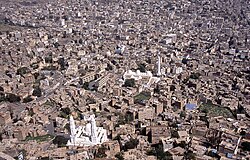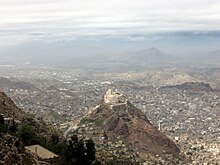Taizz
|
تعزّ Taizz |
||
|---|---|---|
|
|
||
| Coordinates | 13 ° 35 ' N , 44 ° 1' E | |
| Basic data | ||
| Country | Yemen | |
| Ta'izz | ||
| ISO 3166-2 | YE-TA | |
| height | 1370 m | |
| Residents | 453,455 (2003) | |
|
Taizz with the Ashrafiyya Mosque
|
||
Taizz , occasionally also Taʿizz , Taiz or Tais ( Arabic تعزّ) is a city in Yemen with over 450,000 inhabitants (as of 2003). Taizz is located in the governorate of the same name , of which it is the capital.
geography
Taizz is located in the mountains of Yemen at an altitude of 1370 meters on Jabal Sabir , whose summit is 3006 m. It is located between Aden and Sanaa in southern Yemen, and therefore has connections to the ports on the Red Sea , al-Hudaida and Mokka . The mountain range intercepts the air masses advancing from the south and west, which is why the city benefits from higher amounts of precipitation than the rest of the area. This results in the possibility of intensive terracing agriculture and Qat -Anbaus.
history
Under the influence of the Ayyubids and Rasulids , Taizz was one of the capital cities in Yemen, which led to heavy building activity at that time. For example, the Ashrafiyya Mosque was built under the Rasulids . Ibn Battuta reported a flourishing city in the 14th century.
In the 16th century Taizz was occupied several times by the Ottomans . At this time there is also said to have been an important Islamic educational institution on site.
In 1763 the explorer Carsten Niebuhr stayed in the city for half a month. A prospectus view made by him shows that the city had a walling that has been partially preserved to this day as well as the two preserved city gates Bāb al-Kabīr and Bāb Mūsa and the fortress al-Qāhira .
In October 1811, the German traveler Ulrich Jasper Seetzen , who was on his way to the port city of Mokka with 17 heavily laden camels, was found dead near the city . In 1892, the Austrian explorer Eduard Glaser stayed in Ta'izz and recorded a lively qat trade in front of the city gates in his notes.
Under Imam Ahmad ibn Yahya (1948–1961) the city was the last residence and capital of the Kingdom of Yemen . Its palace, built in the style of a Sanaa house, now functions as a city history museum.
As part of the Yemeni protest movements , Taizz was a center of resistance against government authorities in 2011. In September and October Taizz was the scene of regular fighting between government soldiers and armed tribal fighters. On October 5, seven people died in a battle with mortars . On June 5, 2015, the fortress of Al-Qahera (Cairo) overlooking the city was destroyed by the Saudis. Allegedly it was previously used by the Houthi and the armed forces of the expelled President Ali Abdulla Saleh as a military post for shelling opponents in the city.
economy
Ta'izz is the center of coffee growing . There are also textile and jewelry industries and tanneries . Ta'izz Airport offers important transport links for both national and international flight connections. Due to investments from the Gulf Emirates, Ta'izz has a network of paved roads.
Attractions
The city is home to a large number of old neighborhoods . Most of the private houses are built in the typical brick construction. The mosques are mostly kept in white, especially the Aschrafiyya already mentioned above , as well as the Muctabiya and Mudhaffar , which should also be emphasized ; also the old citadel and the governor's palace, which is 450 m above the city on a mountain peak.
Taizz has a Muslim madrasa that even has university claims.
On the way to At-Turba , a village that is considered a water supply refuge , is the mosque of Jufrus , which is also worth seeing .
sons and daughters of the town
- Shalom Sharabi (1720–1777), Kabbalist
- Maeen Abdul Malek (* 1976), politician
- Tawakkol Karman (* 1979), journalist, politician and human rights activist
See also
literature
- Horst Kopp : On the urban development of Ta'izz. In: Yemen-Report 17/2, pp. 11-17, 1986
- Horst Kopp (Editor): Regional Geography Yemen , Dr. Ludwig Reichert Verlag Wiesbaden, 2005, ISBN 3-89500-500-2
Individual evidence
- ↑ Horst Kopp (editor), Yemen geography (2005), Dr. Ludwig Reichert Verlag Wiesbaden, p. 91 (Population figures of Yemeni provincial capitals 2003; calculation by World Gezatteer)
- ↑ Horst Kopp (editor), Yemen geography (2005), Dr. Ludwig Reichert Verlag Wiesbaden, p. 97
- ^ Regional geography Yemen, p. 98
- ^ Josef Wiesehöfer, Stephan Conermann, Carsten Niebuhr (1733–1815) and his time ; P. 163 f.
- ↑ Horst Kopp (editor), Yemen geography (2005), Dr. Ludwig Reichert Verlag Wiesbaden, p. 87
- ↑ The Bedouin is really a humane robber ; in: Frankfurter Allgemeine Zeitung of September 7, 2011, page N4
- ↑ Taiz: 15 dead in new uprisings, accessed on April 19, 2011
- ↑ Yemen: tear gas and live ammunition against demonstrators ( page no longer available , search in web archives ) Info: The link was automatically marked as defective. Please check the link according to the instructions and then remove this notice.
- ↑ Deaths when a Yemeni city was bombarded with mortar shells. In: ORF . October 5, 2011, accessed October 5, 2011 .
- ↑ Al-Qahera fortress destroyed: One of the most important historical sites in Yemen and a UNESCO World Heritage Site hit by Saudi air strikes.
- ^ GW Prothero: Arabia . HM Stationary Office, London 1920, p. 83.
- ↑ Sheila Carapico, Civil society in Yemen: the political economy of activism in modern Arabia ( page no longer available , search in web archives ) Info: The link was automatically marked as defective. Please check the link according to the instructions and then remove this notice.


